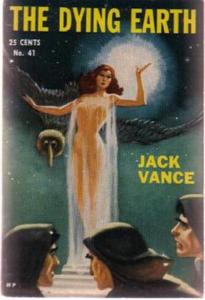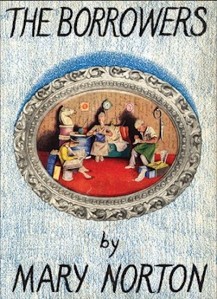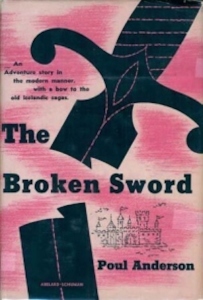
Many would say that fantasy literature as we now know it began in the 50s – specifically with the publication of Tolkien’s Lord of the Rings trilogy. Add to that the release of C.S. Lewis’s Chronicles of Narnia, and you have the emergence of two fantasy worlds that shaped the genre for years to come. These works had such a profound impact they tend to overshadow other fantasies from this decade, but there are still some worth mentioning.
Below I’ve listed what I believe to be the 8 most popular or influential fantasy novels published between 1950 and 1960. I’ve tried to use the original cover or jacket from that year where possible:
(To enlarge a cover simply click on it and the image gallery will open)
-
The Dying Earth
(Dying Earth Series), Jack Vance, 1950
- The Lion, the Witch and the Wardrobe (The Chronicles of Narnia), C.S. Lewis, 1950
- The Borrowers (The Borrowers Series), Mary Norton, 1952
- Charlotte’s Web, E. B. White, 1952
- The Broken Sword, Poul Anderson, 1954
- Half Magic (Tales of Magic), Edward Eager, 1954
- The Fellowship of the Ring (The Lord of the Rings Trilogy), J.R.R Tolkien, 1954
- The Haunting of Hill House, Shirley Jackson, 1959
Pulp magazines had already been publishing fantasy stories and serialised novels in the 30s and 40s, and continued to do so in the 50s, but it was the The Lord of the Rings that brought the genre mainstream popularity and acclaim. It became one of the best-selling series of all time, inspired countless later works, and established epic high fantasy as the core of the genre. While Tolkien had already published The Hobbit in the 30s, The Lord of the Rings garnered more widespread success and helped position fantasy as something that could be read by adults (many previous works had been aimed at children).
C.S. Lewis’s Narnia novels were published in the 1950s and also helped build the prominence of the genre. Unlike Tolkien’s work, however, Lewis’s continued a more established tradition of portal fantasy aimed at children (exemplified by earlier books like The Wizard of Oz, Peter Pan and Alice in Wonderland). Other memorable children’s novels with more subtle fantasy elements, like The Borrowers and Charlotte’s Web, were also published in the 50s.
The Haunting of Hill House may seem a strange inclusion above, since it’s a horror novel, but it is a significant work of paranormal fiction and has influenced the paranormal and gothic fantasy genres.
A Few Interesting Facts
- Tolkien originally intended The Lord of the Rings to be released in one volume, but for economic reasons it was divided and published as three books. Some later editions recombined them into one volume, and many fans still view the series as one book.
- Both C.S. Lewis and Edward Eager were influenced by Edith Nesbit. Eager viewed her as the best children’s author of all time, and Lewis once commented he was working on a children’s novel “in the tradition of E. Nesbit”.
- In an essay titled “It all began with a picture” C.S. Lewis makes it clear the inspiration for Narnia came from an image he’d had in his mind since the age of sixteen of a Faun carrying an umbrella and parcels in a snowy wood.
- All seven Narnia books were published from 1950-56, with one released each year. When the first was published, Lewis had already completed three of the other books.
- Poul Anderson’s The Broken Sword is set during the Viking Age and contains many references to Norse mythology. Writer Michael Moorcock later described it as “one of the most influential fantasy novels I ever read”.
- Jack Vance wrote the stories of the The Dying Earth while serving in the US Merchant Marine during World War II, and the book gave the dying earth sub-genre its name. It features boats propelled by giant sea-worms controlled by “wormringers”. Vance is said to have been influenced by the style of James Branch Cabell (an early 20th Century comic fantasy writer).
- Stephen King called Shirley Jackson’s The Haunting of Hill House “one of the finest horror novels of the late 20th century”. The book is often lauded as the greatest haunted-house story ever written.
Other 50s Works and Authors
There are some works that aren’t included in the list above, either because they were more science fiction or magical realism than fantasy, because I’d already included another work in the same series in the previous decade, because they weren’t novels, or simply because I didn’t feel they were as significant to the genre as others. However, they are still worth mentioning:
- The 13 Clocks by James Thurber (1950)
- The Sword of Rhiannon / The Sea-Kings of Mars by Leigh Brackett, (1953)[originally published in Thrilling Wonder Stories magazine, 1949]
- Mio, My Son by Astrid Lindgren (1954)
- I Am Legend by Richard Matheson (1954) [a science fiction horror novel – very important and influential for vampire and zombie fiction]
- Dandelion Wine by Ray Bradbury (1957)
- The Once and Future King by T.H. White (1958) [collected and revised previous works inc. The Sword in the Stone, listed in 30s & 40s post]
- Gormenghast (1950) and Titus Alone (1959) by Mervyn Peake [The sequels in the Gormenghast series that started with Titus Groan in the 40s]
- The Gammage Cup (The Minnipins Series) by Carol Kendall (1959)
- The Elric tales (novellas published in Science Fantasy magazine) by Michael Moorcock, 1961-1964 (the first Elric novel wasn’t published until the 70s)
- The Finn Family Moomintroll / Trollkarlens hatt (The Moomin Series) by Tove Jansson (Swedish original: 1948, English translation: 1950). This was not the first book in the series but is the most well known.
___________________
Are any of these books a favourite? Or would you add another important novel to the list? Feel free to give it a mention in the comments.








Though not read when first published, yet many of those titles sat upon my first sci-fi/fantasy bookshelf; they remain in my fond memories like dear friends of old.
LikeLiked by 2 people
I also had some of these on my first bookshelf – they do really feel like old friends. I actually have a paperback of The Lord of the Rings that my mother bought in the 70s, so that one even feels like an old family friend!
LikeLiked by 1 person
My thing was Michael Moorcock books. I ended up with almost the full set. And I hadn’t realised they’d been published so early.
LikeLiked by 1 person
Nice! Moorcock really wrote a lot (as I realised when researching this). ‘Elric of Melniboné’ will definitely feature in the main list for the next decade, since it came out in 72. Shamefully I haven’t read any of his books but I want to!
LikeLiked by 1 person
I highly recommend Dancers at the End of Time trilogy.
LikeLiked by 2 people
You don’t realise how they all came out around the same time. That would be a book club I would have LOVED to be apart of.
LikeLiked by 1 person
Yeah that would have been one amazing club!!
LikeLiked by 1 person
One of the first things I remember writing was a feeble attempt to emulate the Narnia books.
LikeLiked by 1 person
The Narnia books really are spellbinding, I can see why you wanted to emulate them.
You know I actually wonder how many of the great writers on these lists started off by attempting to re-create their own childhood favourites!
LikeLiked by 1 person
Or how many of them would admit to writing a form of fan fiction.
LikeLiked by 1 person
I’m a huge fan of Tolkein and Lewis! Also Moorcock featured prominently in my early reading of sci-fi and fantasy. Elric was fun, but I prefer some others, such as the Cornelius chronicles, Dancers at the end of Time, Oswald Bastable (very steampunk, this), and Von Bek. I’ve always felt Elric would make a good movie.
LikeLiked by 1 person
I did wonder how Moorcock’s other works compare, since it seems Elric is the one that is always mentioned even though he has many others, so it’s good to have some recommendations. Thanks! I am actually surprised Elric hasn’t been made into a movie yet, given how popular it is… maybe some day soon it will be. (PS sorry for this incredible delayed reply, I thought I had responded already but I see now I hadn’t!)
LikeLiked by 1 person
Thanks, Nicola for this inspiring blog!
Your new friend,
Saif
LikeLiked by 1 person
Such a great post! And an awesome decade for fantasy!! Of course LOTR and Narnia are favourites of mine, so I’m biased 😉 🙂
I didn’t know C S Lewis’ whole idea came out of that image- that’s such a wonderful, quintessentially Narnia image.
I’m curious about broken sword- to my shame I’d never heard of it. I still need to read haunting of hill house too.
LikeLiked by 1 person
Thanks! And sorry for this terribly slow reply (I only just realised I hadn’t responded yet – I blame my distracted Christmas-holiday brain!). It really was an amazing decade… I think I share your bias 🙂 That image really is so quintessentially Narnia, just picturing it reminds me of the first time I read it and how spell bound I was by it all.
I’m also curious about The Broken Sword, I’ve never read it, but I would like to.
LikeLiked by 1 person
No worries! I can relate lol! 😉 hehe yes! Yes for sure!!
LikeLike
Pingback: Mythical, Mystical, Magical Reading Challenge 2021 (being edited) – Juulna’s 2021 Reading Challenges